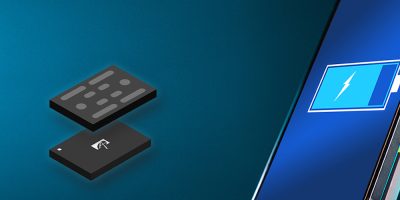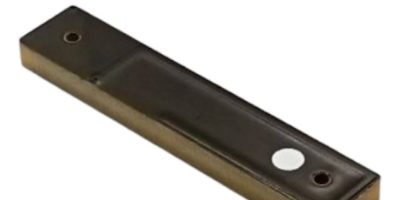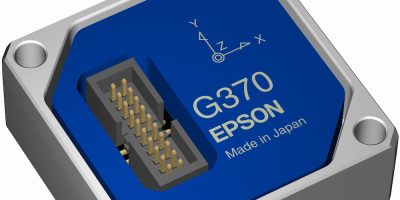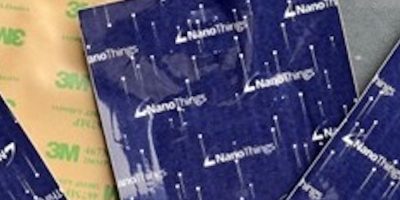Robust package technology, MRigidCSP, by Alpha and Omega Semiconductor (AOS), is initially offered on its AOCR33105E, 12V, common drain, dual N-channel MOSFET. The packaging technology is designed to decrease on resistance while increasing mechanical strength, and is particularly suited to battery applications in smartphones, tablets and ultra-thin notebooks.
AOS explained that fast charging, which requires lower power loss in the battery management circuit, is now widely adopted for portable devices. As the charging currents increase, ultra-low electrical resistance is needed for improved performance. In standard wafer-level chip scale packages (WL-CSPs), the substrate can be a significant portion of the total resistance when back-to-back MOSFETs are employed in battery management applications. A thinner substrate reduces the overall resistance but drastically reduces the package’s mechanical strength. This reduction of mechanical strength can lead to more stress during the PCB assembly reflow process, potentially causing warping or cracking in the die and, ultimately, failure in the application. The AOCR33105E is designed with trench-power MOSFET technology in a common drain configuration for design simplicity. It features low on resistance with ESD protection to improve performance and safety in battery management, such as protection switches and mobile battery charging and discharging circuits.
“Incorporating the AOS MRigidCSP packaging technology with our new dual N-channel MOSFET combines electrical performance improvements with the benefit of high robustness,” said Peter H. Wilson, senior MOSFET product line marketing director at AOS.
AOS designed the MRigidCSP package technology to be used with high aspect ratio CSP die sizes. The CSP construction delivers “a significantly strengthened battery MOSFET that won’t warp or break during the board manufacturing process,” added Wilson.
The AOCR33105E is available in a 2.08 x 1.45mm package, with RDS(on) of 3mOhm at 4.5V / 4.2mOhm at 3.1V.
The AOCR33105E in the MRigidCSP package is immediately available in production quantities with a lead time of 14 to 16 weeks. It is RoHS 2.0 compliant and is halogen-free.
Wearable
Embedded chip antennas are small and durable for the IoT
Surface mounted embedded antennas have been added to the antenna portfolio by Amphenol RF. The surface mounted chip antennas offer electrical performance up to 8.5GHz and support cellular 4G/5G-FR1 frequencies as well as Wi-Fi and Bluetooth / Bluetooth Low Energy (BLE) and LoRa, UWB and GNSS.
The embedded RF antennas are compact and have a durable construction, making them suitable for IoT and smart devices.
By surface mounting the chip antenna directly on the PCB, with antenna ensure there is no need for external antennas. They are manufactured from ceramic or FR-4 materials and are omnidirectional. In addition, said Amphenol RF, they are easy to tune and available in tape and reel packaging.
The small size of ceramic chip antennas enables efficient integration into compact devices where space is at a premium. These antennas are well suited for smart utility meters, robotics, intelligent transport systems, set-top boxes and gateways, and mobile electronic wallets.
Amphenol RF provides local technical support and matching of antennas.
Amphenol RF manufactures coaxial connectors for use in radio frequency, microwave, and data transmission system applications. Headquartered in Danbury, Connecticut, USA, Amphenol RF has sales, marketing and manufacturing locations in North America, Asia and Europe. Standard products include RF connectors, coaxial adapters and RF cable assemblies. Custom engineered products include multi-port ganged interconnect, blind mate and hybrid mixed-signal solutions.
IMU is equipped with six DoF sensor to measure slow and fast motion
IMUs (inertial measurement units) from Epson now include the M-G370G, which has been added to the company’s portfolio.
It allows users to select an accelerometer output range of either ±8G or ±16G and offers 0.05 per cent non-linearity of the full scale range of the gyroscopic sensor. In this way, the M-G370G IMU measure all types of motion, from slow to fast, said Epson.
The IMU is compact, with dimensions of 24 x 24 x 10mm3 and is backwards compatible with the M-G330 and M-G366, M-G370 and M-G370S IMUs which will sharply reduce development costs and evaluation time, noted Epson.
It has a low current consumption of 16mA, making it suitable for vibration damping for cameras and antennas, unmanned vehicles (industrial drones, terrestrial vehicles, sea probes), vibration, angle, trajectory measurement of industrial equipment and for navigation systems (GNSS, INS4, high-precision locators).
Epson will exhibit the M-G370G at Maintenance and Resilience Tokyo 2023 26 to 28 July, at Tokyo Big Sight.
First launched in 2011, Epson’s IMUs have been used in an array of customer applications, from precision agriculture (GNSS2) and industrial drones to camera and antenna platform vibration control and stabilization, earning an excellent reputation for outstanding performance and quality. Epson has a full range of IMUs, from basic models to high-spec models. All are based on a platform that measures about one inch along the sides, the standard form factor for IMUs.
The M-G370G will enter volume production this month.
Epson Europe Electronics is the European headquarters for electronic devices of Seiko Epson, Japan. It is located in Munich, Germany and has several European sales representatives and a European-wide network of distributors.
Epson Europe Electronics provides value added services for timing devices, semiconductors, sensors and sensing systems targeted to various markets like industrial, automotive, medical and communication.
Epson’s goal is to become carbon negative and eliminate use of exhaustible underground resources such as oil and metal by 2050.
Small and versatile geo-location tracker has temperature sensor
Netherlands based SkyNet IoT claims that the LoRaWAN NanoTag is the smallest, most affordable, and most versatile Geo-location tracker and temperature sensor with international LoRaWAN coverage.
Suitable for remote temperature monitoring, the LoRaWAN NanoTag provides geo-tracking and temperature monitoring in a miniature format of just 98 x 130 x 1.5mm.
The NanoTag sticker is a compact, thin, cost-effective temperature sensor with a resolution of 0.1 degrees C. Described as the smallest, most affordable, and most versatile geo-location tracker and temperature sensor in the world, the NanoTag can be used for temperature conditioned transport and logistics as well as for monitoring temperatures in heating and cooling installations.
It has adjustable measurement intervals to provide users with full control. The measurement intervals can be adjusted remotely, allowing users to receive the necessary data exactly when needed. With a measurement interval of, for example, 15 minutes, the NanoTag has a lifespan of several years. This makes it suitable for long term tracking and/or temperature monitoring projects.
The NanoTags are connected to the SkyNet IoT LoRaWAN network as standard. This network provides maximum international coverage and offers secondary network roaming across various connected networks. This is something individual LoRaWAN providers do not offer, said SkyNet IoT. With more than a million connected LoRaWAN gateways from various network providers worldwide, SkyNet IoT claims to offer the maximum coverage and redundancy in LoRaWAN connectivity on the market.
LoRaWAN is the fast-growing IoT standard for sensor connectivity, characterised by its long-distance communication performance with low energy consumption and deep indoor range. Unlike individual LoRaWAN providers, the SkyNet IoT network offers roaming across various connected networks, providing maximum international connectivity.
Although the SkyNet IoT network offers maximum coverage, there may be areas where the (indoor) coverage is absent or limited or where accurate Geo-Location is desirable, said the company. In such cases, the SkyNet IoT network can be expanded to unlock a (larger) (indoor) area and/or to achieve accurate Geo-Location. Although SkyNet IoT offers maximum international coverage, the NanoTags are bound to the frequency bands of specific continents, said the company. For this reason, SkyLab can provide a multi-band solution if required.
The LoRaWAN NanoTag is a versatile tool for refrigerated transport, where temperature and location monitoring are crucial when transporting medicines, organs, chemicals, or fresh products like vegetables and fruit.
SkyLab B.V. offers the NanoTag in a complete package with a customer IoT Dashboard and the SkyNet IoT network, for a one-time fee of $60 each (the price is lower for large quantities). This all-in package contains no hidden costs and is valid for the full lifespan of the NanoTag. Demo NanoTags are available for evaluation.
About Smart Cities
This news story is brought to you by smartcitieselectronics.com, the specialist site dedicated to delivering information about what’s new in the Smart City Electronics industry, with daily news updates, new products and industry news. To stay up-to-date, register to receive our weekly newsletters and keep yourself informed on the latest technology news and new products from around the globe. Simply click this link to register here: Smart Cities Registration







